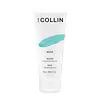G.M. Collin Aqua Masque Versus I'm from Honey Mask
What's inside
What's inside
 Key Ingredients
Key Ingredients

 Benefits
Benefits

 Concerns
Concerns

 Ingredients Side-by-side
Ingredients Side-by-side

Water
Skin ConditioningButyrospermum Parkii Butter
Skin ConditioningC15-19 Alkane
SolventGlycerin
HumectantC10-18 Triglycerides
EmollientNiacinamide
SmoothingCaprylic/Capric Triglyceride
MaskingC12-16 Alcohols
EmollientPropanediol
SolventCetyl Alcohol
EmollientHydrogenated Lecithin
EmulsifyingPalmitic Acid
EmollientPanthenol
Skin ConditioningMauritia Flexuosa Fruit Oil
Skin ConditioningYeast Extract
Skin ConditioningCaprylhydroxamic Acid
Soy Amino Acids
Skin ConditioningMyrciaria Dubia Fruit Extract
Skin ConditioningAsparagopsis Armata Extract
Skin ProtectingAscophyllum Nodosum Extract
Skin ConditioningRosmarinus Officinalis Leaf Extract
AntimicrobialSodium Hyaluronate
HumectantGlucomannan
Skin ConditioningTocopherol
AntioxidantEthylhexyl Palmitate
Emollient1,2-Hexanediol
Skin ConditioningStearyl Alcohol
EmollientTitanium Dioxide
Cosmetic ColorantCarbomer
Emulsion StabilisingXanthan Gum
EmulsifyingParfum
MaskingSorbitol
HumectantButylene Glycol
HumectantTriethanolamine
BufferingSclerotium Gum
Emulsion StabilisingLecithin
EmollientPullulan
Trihydroxystearin
Skin ConditioningCI 15985
Cosmetic ColorantSilica
AbrasiveWater, Butyrospermum Parkii Butter, C15-19 Alkane, Glycerin, C10-18 Triglycerides, Niacinamide, Caprylic/Capric Triglyceride, C12-16 Alcohols, Propanediol, Cetyl Alcohol, Hydrogenated Lecithin, Palmitic Acid, Panthenol, Mauritia Flexuosa Fruit Oil, Yeast Extract, Caprylhydroxamic Acid, Soy Amino Acids, Myrciaria Dubia Fruit Extract, Asparagopsis Armata Extract, Ascophyllum Nodosum Extract, Rosmarinus Officinalis Leaf Extract, Sodium Hyaluronate, Glucomannan, Tocopherol, Ethylhexyl Palmitate, 1,2-Hexanediol, Stearyl Alcohol, Titanium Dioxide, Carbomer, Xanthan Gum, Parfum, Sorbitol, Butylene Glycol, Triethanolamine, Sclerotium Gum, Lecithin, Pullulan, Trihydroxystearin, CI 15985, Silica
Honey
HumectantCaprylic/Capric Triglyceride
MaskingPEG-7 Glyceryl Cocoate
EmulsifyingDisteardimonium Hectorite
StabilisingMacadamia Ternifolia Seed Oil
EmollientHelianthus Annuus Seed Oil
EmollientPentylene Glycol
Skin ConditioningMicrocrystalline Wax
Emulsion StabilisingPolysorbate 20
EmulsifyingButyrospermum Parkii Butter
Skin ConditioningBeeswax
Emulsion StabilisingTocopheryl Acetate
AntioxidantArgania Spinosa Kernel Extract
Skin ConditioningCorylus Avellana Seed Oil
EmollientSimmondsia Chinensis Seed Oil
EmollientSnail Secretion Filtrate
Skin ConditioningWater
Skin ConditioningBambusa Vulgaris Water
Skin ConditioningNelumbo Nucifera Flower Water
TonicAloe Barbadensis Leaf Water
MaskingPropolis Extract
Skin ConditioningBeta-Glucan
Skin ConditioningBee Venom
AstringentCitrus Paradisi Fruit Extract
Skin ConditioningSophora Flavescens Extract
Skin ConditioningEugenia Caryophyllus Flower Extract
AstringentEucalyptus Globulus Leaf Extract
PerfumingPunica Granatum Fruit Extract
AntioxidantBambusa Vulgaris Extract
Skin ConditioningButylene Glycol
HumectantGlycerin
HumectantHoney, Caprylic/Capric Triglyceride, PEG-7 Glyceryl Cocoate, Disteardimonium Hectorite, Macadamia Ternifolia Seed Oil, Helianthus Annuus Seed Oil, Pentylene Glycol, Microcrystalline Wax, Polysorbate 20, Butyrospermum Parkii Butter, Beeswax, Tocopheryl Acetate, Argania Spinosa Kernel Extract, Corylus Avellana Seed Oil, Simmondsia Chinensis Seed Oil, Snail Secretion Filtrate, Water, Bambusa Vulgaris Water, Nelumbo Nucifera Flower Water, Aloe Barbadensis Leaf Water, Propolis Extract, Beta-Glucan, Bee Venom, Citrus Paradisi Fruit Extract, Sophora Flavescens Extract, Eugenia Caryophyllus Flower Extract, Eucalyptus Globulus Leaf Extract, Punica Granatum Fruit Extract, Bambusa Vulgaris Extract, Butylene Glycol, Glycerin
 Reviews
Reviews

Alternatives
Ingredients Explained
These ingredients are found in both products.
Ingredients higher up in an ingredient list are typically present in a larger amount.
Butylene Glycol (or BG) is used within cosmetic products for a few different reasons:
Overall, Butylene Glycol is a safe and well-rounded ingredient that works well with other ingredients.
Though this ingredient works well with most skin types, some people with sensitive skin may experience a reaction such as allergic rashes, closed comedones, or itchiness.
Learn more about Butylene GlycolThis ingredient is also known as shea butter. It is an effective skin hydrator and emollient.
Emollients help soothe and soften your skin. It does this by creating a protective film on your skin. This barrier helps trap moisture and keeps your skin hydrated. Emollients may be effective at treating dry or itchy skin.
Shea butter is rich in antioxidants. Antioxidants help fight free-radicals, or molecules that may harm the body. It is also full of fatty acids including stearic acid and linoleic acid. These acids help replenish the skin and keep skin moisturized.
While Shea Butter has an SPF rating of about 3-4, it is not a sunscreen replacement.
Shea butter may not be fungal acne safe. We recommend speaking with a professional if you have any concerns.
Learn more about Butyrospermum Parkii ButterThis ingredient is an emollient, solvent, and texture enhancer. It is considered a skin-softener by helping the skin prevent moisture loss.
It helps thicken a product's formula and makes it easier to spread by dissolving clumping compounds.
Caprylic Triglyceride is made by combining glycerin with coconut oil, forming a clear liquid.
While there is an assumption Caprylic Triglyceride can clog pores due to it being derived from coconut oil, there is no research supporting this.
Learn more about Caprylic/Capric TriglycerideGlycerin is already naturally found in your skin. It helps moisturize and protect your skin.
A study from 2016 found glycerin to be more effective as a humectant than AHAs and hyaluronic acid.
As a humectant, it helps the skin stay hydrated by pulling moisture to your skin. The low molecular weight of glycerin allows it to pull moisture into the deeper layers of your skin.
Hydrated skin improves your skin barrier; Your skin barrier helps protect against irritants and bacteria.
Glycerin has also been found to have antimicrobial and antiviral properties. Due to these properties, glycerin is often used in wound and burn treatments.
In cosmetics, glycerin is usually derived from plants such as soybean or palm. However, it can also be sourced from animals, such as tallow or animal fat.
This ingredient is organic, colorless, odorless, and non-toxic.
Glycerin is the name for this ingredient in American English. British English uses Glycerol/Glycerine.
Learn more about GlycerinWater. It's the most common cosmetic ingredient of all. You'll usually see it at the top of ingredient lists, meaning that it makes up the largest part of the product.
So why is it so popular? Water most often acts as a solvent - this means that it helps dissolve other ingredients into the formulation.
You'll also recognize water as that liquid we all need to stay alive. If you see this, drink a glass of water. Stay hydrated!
Learn more about Water